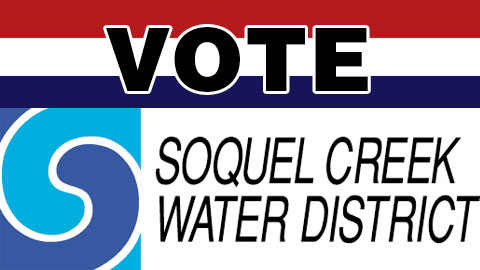
It all comes to a head in the election for new Directors to make decisions about the future of our water. Three seats are open on the board with two of the incumbents, Bruce Jaffe & Rick Meyer, running for re-election and seven new candidates, Carla Christensen, Doug Deaver, John Hughes Jr., Maria Marsilio, Bill McGowan, John Prentice, and Michelle Roy, all wanting to fill the three openings.
Times Publishing Group, Inc., as the publisher of the Aptos Times and Capitola Soquel Times, is devoted to the task of informing the voters concerning the candidates’ positions on current issues rather than endorsing a particular person for the office. We asked these three questions of the nine candidates:
- Question 1: Of the alternative water supplies studied, which one would you choose and why?
- Question 2: Do you support a monthly water budget of 75 gallons per person per day for residential water users?
- Question 3: Do you agree that a building moratorium is a viable way to help prevent saltwater intrusion?
Here are their answers in the order received. (John Hughes Jr. did not respond before going to press)
Q1 Of the alternative water supplies studied, which one would you choose and why?
Q2 Do you support a monthly water budget of 75 gallons per person per day for residential water users?
Carla Christensen: It is regrettable that the old board majority put us in this situation where we have to work hard to conserve until we can get a new water source. Given the disastrous effects of over 30 years of overpumping and the resulting saltwater intrusion, I must support the 75 per person per day monthly allotment. There needs to be an appeal process and exceptions for need as part of this plan. And I would increase rebates to motivate even more water saving.
Shellie Roy: The members of the SCWD voluntarily reduced overall consumption by 16% in June. Setting 75 gallons as an optimum target assists residents with a quantifiable goal. But mandatory rationing with punitive fines and no long- term plan — achieves nothing but ill will. Rethinking and changing norms in water uses, landscape choices, etc. are part of a sustainable solution. But conservation can’t conserve water we don’t have. It is also necessary to utilize technological innovations to assist and expand the water nature provides. Population is growing. When I was a child California was the ‘fruit basket of the world.’ We need to grow our water supply to meet both agricultural and residential requirements.
Maria Marsilio: There has been active public comment about this plan at the Board meetings. The Board of Directors stated in a public meeting that they came up with the quantity of 75 gallons per person per day by looking at average usage. If this Conservation Plus program is put in place, I will actively help the users to understand methods so that they can live within their water budget comfortably and thus will not need to be charged higher fees for going over their allotment. I have numerous fresh ideas for engaging a wide circle of users. I strongly support empowering users to be part of the solution and encourage their input.
Rick Meyer: Our District staff designed a ConservationPlus program that would involve a water budget. The board has heard a lot of compelling criticisms at our hearings. As a result, we unanimously decided to re-examine the program. The majority of our customers would already be under budget most of the year, but when they are over budget, there is often a good reason. The District should only care about long term water use, since we have a long-term problem, so the proposed monthly penalties do not make sense. I also voted to re-examine the program because its goals for water savings have already been met twice over through the recent voluntary efforts of our customers. We are very appreciative of the way the community has come together to achieve this. Beyond a certain point, conservation becomes a hardship and increasingly expensive measures would be needed. That is why we need a supplemental supply — to avoid that hardship.
Bruce Jaffe: Some residential single-family home water uses have monthly bills of $3,000. They use more than 2,000 gallons/day. Is that fair to our other customers, who are doing their part to conserve water and help slow seawater intrusion? Admittedly, this is the extreme user. But, in the winter when outdoor use is less, 3% of our customers use 10% of the water and 25% of our customers use 50% of the water. I think that our customers can, and are willing to, do more to keep seawater in the Bay, where it belongs—not in our groundwater basins. As a Director, I heard what our customers were saying, “The program of 75/gal per person per day has problems.” The District is, with your help, coming up with a program that will reduce pumping to let groundwater levels recover to above sea level. Thank you for all that you are doing to help!
Bill McGowan: I do not support mandatory monthly water budgets of 75 gallons per day. That type of restriction is not healthy or needed for our community. Current conservation efforts by our community have already reduced water usage by over 20% in the last year with a net decrease in pumping over the last 10 years. As a community, we are headed in the right direction without adopting mandatory restrictions. I do support continued education and community involvement in building a sustainable water supply for our community.
Doug Deaver: I support continuing this program on a voluntary basis at the current time while we continue to evaluate the condition of the basin and while we pursue basin wide collaboration for a total solution. Community response to me is that people are willing to live out of buckets for the short term, but they don’t want mandatory rationing at this level (or worse) to be the way of life for the next 10 or 20 years.
John Prentice: I do not support mandatory monthly water budgets of 75 gallons per day. I do support a new billing rate structure that rewards those who are able to adjust their life style and conserve below that amount. Unlike the current rate structure that has heavy penalties and fines for customers, I believe we should move towards a process that rewards those who conserve. We have to many fixed income households in our community to be hitting them with large fines and penalties that are totaling up to more than 200% more than neighboring cities that pump from same source.
Q3 Do you agree that a building moratorium is a viable way to help prevent saltwater intrusion?
Carla Christensen: The best way to stop saltwater intrusion is by achieving a safe balance between water extracted from and going into our aquifers. Large new projects that will increase our overall water demand will not help that equilibrium. The Water Offset program only buys us time until we can find a secure new source to replenish our strained aquifers. No one wants to stop all growth. Allowing such things as single-family residences and home and small business additions and remodels should remain part of the fiber of our ordinary lives. Existing ratepayers should not have to endure onerous conservation rules or pay more to enable new large projects while builders reap large profits. A moratorium, complete or partial, is not a solution but, at best, a stopgap measure to halting the saltwater intrusion that now threatens our water source. The permanent poisoning of our water supply would be worse for our economy than any moratorium. Our best solution is finding new water sources that allow reasonable growth within the framework of our current zoning laws.
Shellie Roy: A Moratorium can’t undo 30 years of over draft but grey water on open lands like Seascape’s golf course would form a barrier to salt water intrusion. A building moratorium addresses 2% of aquifer draw with no impact on 98% of current water users, including 50% on private wells. But worse, moratoriums aren’t neutral in their effects – moratoriums harm the households in our community’s middle class. As a former policy maker in Aspen, Colorado (County Commissioner / Supervisor; Planning & Zoning Commissioner; and Chair of the Clean Air Advisory Board) I saw that moratoriums did not accomplish our long-term purposes, and worse — they drove out the large and economically critical sector of people engaged in remodeling, selling and building real estate. This is our middle class — the people who make the community. A moratorium is a very, very bad idea.
Maria Marsilio: My opinions on this subject have evolved. There is very little buildable land in the District. So, re-models and single family dwellings do not add significantly to the amount of water that is being pumped from the aquifer.
Rick Meyer: Although as a Board member, I had seriously considered a moratorium, we found a better way. The potential moratorium did not even come up for a vote. Until a supplemental water supply project is built, we will be dealing with a shortage. People who are doing their best to conserve wonder how we can at the same time issue new water hookups. We are doing so through a restructured water demand offset program. People who build and need a new water meter pay for projects that reduce water demand somewhere in the District by 200% of their projected demand. We improved the program so that the savings from such projects will be measureable, very long term, and would not have happened anyway. This way the new hookups will not increase water use, at least not until the supplemental supply is built. The moratorium exploration is behind us now, and neither staff nor board members have suggested bringing it up again.
Bruce Jaffe: No. Through the water demand offset program where new water use is offset by water saving financed by those who want the new water, the groundwater basin does not suffer in the short term. In the long term, additional water supply is the answer to recover our groundwater basin and to ensure clean, safe, water for future generations.
Bill McGowan: No, a building moratorium enacted by the Water District would not help prevent seawater intrusion and would be harmful to our community. Along with the negative impacts on our local economy, a building moratorium will contribute to the installation of more private wells (to get around the moratorium) and more uncontrolled pumping in our aquifer; thereby increasing the risk of seawater intrusion. Driving community members away from the District because of a building moratorium creates more division and seawater intrusion risk for our aquifer. Effectively preventing seawater intrusion is an aquifer-wide issue that will require collaboration by all water users in our ground water basin. In terms of growth, our community is pretty well built out with less than 2% growth projected over the next 10 years. A building moratorium would have terrible impacts on local businesses, residential and small food producers, the entire local construction industry and our overall quality of life.
Doug Deaver: I believe that a building moratorium is not a viable solution. First of all Soquel Creek Water users account for less than 50% of the basin usage, and the other usage is not under any restriction. Second a moratorium means that ALL new hookups are bad – medical facilities, school projects, churches, etc., and I don’t believe that to be the case. Third a moratorium means that the Soquel Creek Water District won’t allow new hookups; however, new development can still elect to pursue drilling a well to provide needed water. I believe that Soquel Creek water policies should encourage new users to use District resources, not drill new wells.
John Prentice: I absolutely do not agree with the moratorium as a way to prevent saltwater intrusion. This is very closed-minded thinking that will not accomplish the long-range goals to protect our water source for future generations. Soquel Creek water experts have predicted a 2% increase over the next 10 years without a moratorium. That is very minimal compared to the immediate and long-term economic disaster would cause toward our local community.

